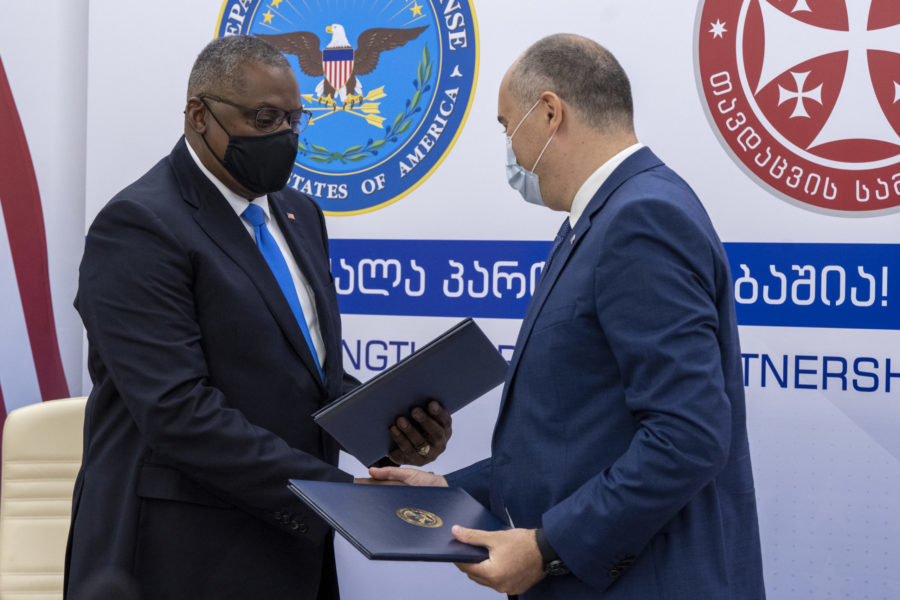Before Russia took NATO by surprise in 2014, invading Ukraine and taking the Crimean peninsula, some 200 miles from NATO shores, there was Georgia. In the Georgian provinces of South Ossetia and Abkhazia in 2006, Russian President Vladimir Putin spurred a frozen conflict, and Russia still occupies some 20 percent of Georgian territory.
Defense Secretary Lloyd J. Austin III visited Tbilisi on Oct. 18 ahead of the NATO ministerial meetings in Brussels Oct. 21-22. He assured the aspiring NATO member that the U.S. is at its side. During the visit, he signed a defense memorandum to enhance deterrence amid continued Russian hybrid warfare, including disinformation and cyberattacks.
Austin also met with Defense Minister Juansher Burchuladze and Prime Minister Irakli Garibashvili while in the Black Sea country. In public remarks, Austin thanked Georgia for contributing forces to Afghanistan and Iraq, and he highlighted progress Georgia is making to reach NATO interoperability.
“Georgia has paid a heavy price with 32 killed in action and 293 wounded in Afghanistan,” Austin said, while underscoring the “tremendous value” of the Georgia-U.S. partnership.
“This is a critical region to us,” he added. “We have many shared interests and, of course, shared values, and we see a number of opportunities for security cooperation.”
Sandwiched between Russia and NATO ally Turkey on the eastern shore of the Black Sea, Georgia had been one of the most vocal pro-western countries in the region, but its ruling party has made recent overtures toward Moscow, former U.S. ambassador to Georgia Ian Kelly indicated in an August Foreign Policy article.
With Russia already strengthening its Black Sea Navy fleet and boosting its anti-access, area denial capabilities near NATO’s eastern flank, Austin’s visit and promise to help resist Russian pressure could not come soon enough.
In 2018, the United States launched a $53.4 million Georgia Defense Readiness Program and began training Georgian troops for the first time to protect their own sovereign territory. The program, run by Army and Marine Corps personnel deployed to Georgia, trained infantry companies and tactical unit commanders while also helping Georgia create policies and processes to train and equip their own forces. During the visit, Austin witnessed a medical training event and met with U.S. special operations forces deployed to Georgia.
With the readiness agreement expiring at the end of 2021, Austin and Burchuladze inked a new Georgia Defense and Deterrence Enhancement Initiative.
The six-year deterrence plan will strengthen and modernize Georgia’s military institutions and further NATO interoperability, focusing on higher-level military units and operations. U.S. personnel will also help train Georgia’s maneuver brigades in combined arms operations to integrate fires and engineering capabilities.
“Georgia continues to make progress in terms of military reform and capabilities,” Austin said after what he called an “excellent brief” by Georgia Defense Forces leaders on areas of improvement.
The agreement will give Georgia additional capability to train their forces, Austin added.
In a meeting with Prime Minister Garibashvili, Austin was forceful in outlining the threat Georgia faces from Russia.
“The United States condemns Russia’s ongoing occupation of Georgia and its attempts to expand influence into the Black Sea region through military coercion and malign activities,” he said.
Georgian media reported that Garibashvili in public comments following his meeting with Austin later in the day emphasized how the U.S. will help modernize Georgia’s defense forces and declared Georgia “a loyal ally [to the U.S.] in the region.”
